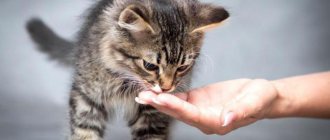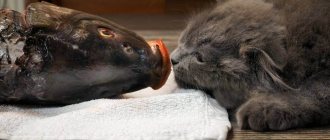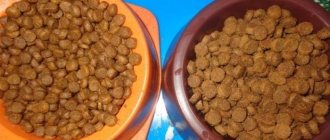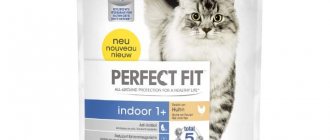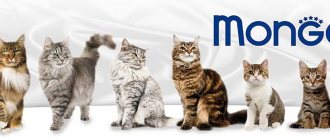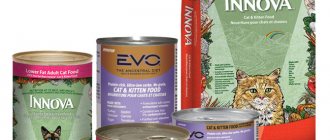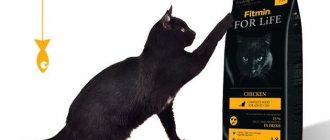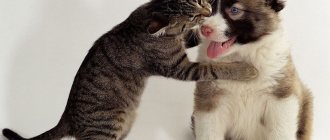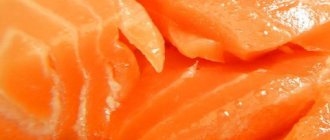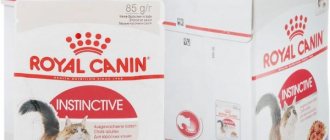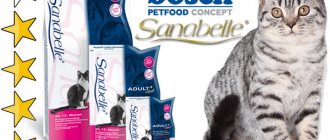Types of feed
There are two types of food - dry and wet (canned). The first is made from products that are exposed to high temperatures. Then they are passed through a special machine (extruder), where they are twisted in a similar way to a meat grinder. The strips that come out of the nozzle are cut into pellets, dried and sold.
Dry granules are more convenient to store and take on the road. If you follow the dosage, the risk of obesity in your cat is minimal. The downside is that the animal needs a lot of water. If your pet drinks little fluid, dehydration and urolithiasis may occur.
Canned food is easily digestible and satisfies the cat's need for water. They contain whole pieces of meat that pets like, and they eat them with pleasure. The downside is that canned goods of the same class as dry granules are more expensive, and the consumption is higher; the shelf life after opening is a couple of days in the refrigerator.
What you need to know about the composition of feed
Now let’s talk about the intricacies of food of various classes, which will help you not make a mistake in your choice:
- Always study the composition of the food indicated on the packaging. For quality feeds, the ingredients are indicated as a percentage and in descending order. The absence of this information indicates that this is a product of dubious quality.
- The packaging of high-quality food always indicates what kind of meat was used in its production. If there is no such decoding, this is a lower-than-premium product.
- Pay special attention to identifying the meat component. The mark “dehydrogenated” will indicate that the amount of meat in the feed corresponds to its presence. The absence of such a mark will indicate that the meat in the mixture has a raw appearance, and its quantity is 3 times less than indicated on the label.
- From the feeds, it is better to choose the one whose packaging contains a breakdown of the by-products used in its composition (liver, lungs, heart). The label “animal products” most likely indicates that bones, beaks, hooves and skin were used as by-products.
- Cats are carnivores by nature, which means the lower the grain content in the food, the better.
- The presence of berries and fruit mixtures, probiotics and prebiotics in the composition indicates the high quality of the product.
- The presence of soy or soy concentrate in the feed is undesirable. Along with corn, this product often causes allergies in members of the cat family.
- The mark “poultry” or “animal” fat in the mixture indicates its low quality. A quality product usually lists “fish” or “chicken” fat.
- If your pet has undergone sterilization or castration, if he suffers from obesity or urolithiasis, therapeutic and preventive food will be optimal for him.
- Pregnant and lactating cats will need food with a higher calorie content. Manufacturers of high-quality feed, as a rule, have corresponding lines.
Finally, remember that regardless of the quality of the food purchased, your pet should have free access to water. It will protect your four-legged friend’s body from dehydration!
Wet or dry - which is better?
Both canned food and dry food have their pros and cons. For example, dry kibble causes increased alkaline urine production. This stimulates the formation of struvites (a type of stone) in the urinary system.
Manufacturers take this fact into account and add substances that oxidize urine. This leads to the formation of other stones - oxalates. To avoid problems, when purchasing food, you need to pay attention to the acidity of the food consumed.
It’s not easy with canned food either. Some products may contain soy, which causes allergies in cats. In addition, you need to pay attention not only to the composition, but also to the packaging. Cans with “POP” lids can cause hyperthyroidism (thyroid problems) in cats due to bisphenol A. This substance is part of these lids and can end up in canned food.
Premium food
You should not be impressed by the word “premium” in the name of the class, because in terms of its composition, these products are not very different from economy-class feed.
The content of animal proteins in this food is slightly higher - 4-10%, which significantly increases the digestibility of food. However, by-products and animal waste still prevail as meat ingredients.
The basis and main source of carbohydrates in premium foods are still soy, wheat and corn, which are poorly absorbed by the body of four-legged animals, and besides, they often cause allergies.
But in fairness, we note that when producing premium food, higher quality products are usually used. Cat food contains virtually no dyes or preservatives, and the composition itself is more balanced in terms of the ratio of fats, proteins and carbohydrates. Moreover, these products have a wider vitamin and mineral group, which makes the composition somewhat healthier.
Premium food
Finally, premium foods offer a wider variety of food textures. We know how picky cats are about the monotony of food, and they all periodically need a change in texture. In this regard, premium food undoubtedly wins.
Let us only note that the cost of premium feed is 2-3 times higher than the cost of economy class feed. And this price is not due to the increased quality of the food, but to the high costs of advertising!
Important! Premium-class food is “famous” for its heterogeneity in the selection of components, and therefore two products with the same price can differ dramatically in composition, both in one direction and the other. Therefore, when choosing such food, you should carefully study the composition of the product.
List of brands
When choosing the most optimal products of this class, we recommend paying attention to the following brands:
- "Hills" (produced in the Netherlands and USA);
- "Brit Premium" (made in the Czech Republic);
- "Eukanuba" (made in Russia);
- "Organix" (made in the Netherlands);
- "Probalance" (made in Russia).
Separately, it is worth mentioning two more brands - “Royal Canin” and “Pro Plan”. In terms of quality, they are no different from the brands listed above, but thanks to advertising, the prices for food of these brands are much higher.
How to choose food?
If you want your cat to be healthy, active, and live long, buy a quality product. It should contain meat, taurine (an essential amino acid), vitamins, minerals, enzymes, and fats that are beneficial for pets.
Studies have shown that food containing more meat is much superior in digestibility and nutritional value to products based on grains. Thus, “meat food” allows the owner to save money, since less granules need to be given.
Also make sure that the granules do not contain flavorings, preservatives, or dyes. Manufacturers add them to satisfy the aesthetic needs of the cat's owner, but they are of no benefit and are even harmful.
Classification of cat food by class
When choosing wet or dry cat food, consider the quality classification:
- economy;
- premium;
- super premium;
- holistic.
Economy class food for cats
Economy class food is cheap (Whiskas, Kitekat, Friskies, Felix, Sheba, Meow), and in most cases this is their only advantage. Then everything depends on the integrity of the manufacturer. The composition may be good, but unstable. Its contents vary depending on what product the manufacturer was able to obtain at a cheap price. Therefore, the composition on the label often does not correspond to the real one.
But in most cases, economy-class food cannot boast of a good composition, and there is little meat in it. The problems are:
- Food contains flavorings, preservatives, and additives that cause stomach irritation, vomiting, and diarrhea.
- Economy class feeds are characterized by low nutritional value. Therefore, the cat, in order to get enough, eats several times more, and constantly walks around hungry. This contributes to obesity due to a lack of nutrients that the cat absorbs from food.
- If a cat is regularly fed a bad product for several years, serious diseases may develop that will require expensive treatment.
- Allergies due to large amounts of cereals, preservatives, and flavorings.
If you still want to buy an economy product for your cat, study the composition. A specific source of protein must be indicated there - not meat, but chicken, turkey, beef. He should be in first position. The amount of grains should not exceed more than 50%. Cats are carnivores and cannot live on a vegetarian diet. Therefore, there should be few grains and vegetables.
Premium cat food
Premium class (SPORTMIX Gourmet Mix) has a balanced composition that fully corresponds to the inscription on the label. It is much more nutritious than economy class - the products included in its composition are absorbed by 70%. Medium-class cat food contains meat, vitamins, minerals, omega-3 fatty acids, and other beneficial substances. However, the proportion of grains in them is large, so they can cause allergies.
The premium line includes products for sick animals. For example, Farmina Matisse food prevents obesity, is recommended for the prevention of urolithiasis, and is beneficial for neutered cats. Moreover, the line includes both premium and super-premium food.
Super premium cat food
Super premium cat food is hypoallergenic. They contain a lot of meat and nutrients. They contain few or no grains, no flavorings, or other harmful substances. The composition fully corresponds to that indicated on the packaging. The body absorbs it by 90%, so you can give your cat a smaller portion in grams compared to premium.
Inexpensive premium cat food includes products produced under the following brands:
- Acana;
- Pronature Original;
- Eminent.
Good premium cat food from the Dr. Clauder's brand. They are recommended for pathologies of the digestive tract, for the prevention of urolithiasis, and other problems. Their line includes food for pets who do not go outside, as well as premium hypoallergenic cat food.
Types of feed depending on the age of the animal
In most lines of holistic classes there is no division into age categories of animals. In the case of the super-premium category, this occurs, but rarely. The production of products for animals of different ages is more typical of low-quality brands, since good food is suitable for all healthy pets. Traditionally, manufacturers develop formulations for kittens, adult cats and elderly pets.
Kitten food
Kittens require more calories and nutrients (vitamins, minerals and amino acids) as their internal organs and systems actively develop. Useful compounds are used as building materials for fabrics. If an adult animal can tolerate nutritional deficiency for a long time without critical consequences, then in the case of kittens, even 5–7 days at an early age (1–2 months) can cause the development of chronic diseases.
Despite the manufacturer’s assurances, it is better not to give Whiskas food to kittens: such nutrition will lead to the development of pathologies even at the time of the final formation of internal organs
Kitten foods often include fish oil, salmon oil and tocopherols in high concentrations. Unsaturated fatty acids and vitamin E help improve immunity and the condition of the nervous system. Some manufacturers use dairy products and extracts as a replacement for mother's milk. They partially supply the kitten’s body with antibodies.
The fact that the food is suitable for kittens may indicate
For small kittens, wet food is preferable. It is close in consistency to regular food, so the gastrointestinal tract adapts gradually. Dry food can also be given to kittens after a month, but it is recommended to soak it first.
Food for adult cats
Foods for adult cats are universal standard products that have an average concentration of nutrients and normal calorie content. Such diets are suitable for almost all animals without special needs. They can be given even to elderly pets in the absence of problems with excess weight, if the composition includes preventive supplements.
The “Adult” mark indicates that the food is suitable for adult cats.
Food for older cats
Manufacturers recommend giving food to older cats from the age of 7 years, but in reality, with good care and normal health, the animal may only need the diet after 10–12 years. Most often, such diets reduce calorie content by reducing the proportion of fat. This helps to simultaneously reduce the load on the liver and prevent excess weight.
Manufacturers may indicate recommended age limits on packaging
Obesity is quite common in older cats due to decreased activity. Excess weight at this age poses a great threat, since it can increase the load on the joints. In old age, problems with the musculoskeletal system often appear. To prevent damage to cartilage and joints, manufacturers include sources of glucosamine and chondroitin in the food: cartilage, mussel extract, crab shells, etc. However, diets with such additives are recommended to be given to young cats, since they may not help at an older age.
The “Senior” label may indicate that the food is suitable for older cats.
Older cats, like kittens, should be given wet food if they have chronic diseases. This will reduce the severity of symptoms in gastrointestinal and oral pathologies. In such cases, spiders are combined with dry food, but given at different times so as not to provoke digestive upset.
Holistic class cat food
Holistic (Orijen, PureLuxe) is made from the meat of farm animals and birds that have had the opportunity to freely graze. They were not injected with antibiotics or given hormones. The vegetables and grains that make up the food were grown without pesticides. Such products are as balanced as possible and fully meet the nutritional needs of cats.
For example, the PureLuxe line of food does not contain grains, to which animals often develop reactions. PureLuxe is easily digestible, has a good effect on the gastrointestinal tract and joints, and contains little fat, so the animal does not risk gaining weight.
Super premium food
These mixtures can truly be classified as elite feeds, since the quality of this product is an order of magnitude higher than economy and premium feeds.
The key advantage of super-premium food is that the source of protein in them is animal products. Meat and meat products in such compositions are at least 20%, due to which the digestibility of food by the body of four-legged pets is significantly increased.
Important! Super-premium food is made from first-class meat, as well as offal (heart, kidney, liver and tongue), of high quality.
Rice, oats or barley are used as grain crops in such feeds (less allergenic compared to corn or wheat). Some foods contain vegetable proteins from potatoes or peas, but corn gluten, which is common in cheap foods, is excluded!
A distinctive feature of super-premium food is its rich composition of vitamins and minerals, as well as the presence of natural vegetables that replenish fiber reserves. Flavoring additives, dyes and preservatives in such products are strictly prohibited! Even rosemary components and vitamin E are used as antioxidants.
Super premium food
To confirm the quality of such products, on the packaging of the feed you can always find detailed information about the ingredients present in the composition in percentage terms.
Important! Very often, super-premium products have breed, medical and dietary lines, the transition to which is usually prescribed by a veterinarian.
Specialists also took care of a variety of pellets for animals of different weights, sexes and ages. It’s safe to say that the producers of this food put animal health at the forefront!
List of brands
What is typical is that, in contrast to premium foods, in this group differences in composition are noticeably less common. The following brands have the most expressive price-quality ratio:
- "Summit" (made in Canada);
- "Leonardo" (made in Germany);
- "Brit Care" (made in the Czech Republic);
- “Fitmin For Life” (made in the Czech Republic);
- "Blitz" (made in Russia).
Cat food classes: rating
On the Internet you will find different ratings, where the same product can top the first or last line of the list. The fact is that the cat’s body perceives the same food differently. Suitable for some pets, not for others.
Granules should be selected not so much by rating, but by quality:
- The first place will always be super holistic class cat food - PureLuxe, Orijen.
- In second place are super-premium products. This is Dr. food. Clauder's, Pronature Original, Eminent, Acana, etc.
- In third place is premium – SPORTMIX Gourmet Mix.
Economy feeds occupy the last positions. You cannot give them to your pet regularly - he can get poisoned, get sick, or die prematurely.
Choosing dry food: recommendations
After a thorough analysis, it is clear: no one should buy economy-class products, they are not cheaper than others, and they only bring harm to the cat. Premium does not bring any harm or benefit to a cat; you can live on it for a short time. Super-premium and holistic food are the best choice and even treat the pet, however, the latter can only be recommended to professional owners who are ready to share food with the cat, as they say, “from their table.” In general, it is impossible to give absolute advice on choosing food, because all cats and their owners are different, however, this article provides recommendations that will help you make your choice.
Rules for feeding cats
- Buy food products only in specialized stores and veterinary pharmacies. Ignore bazaars - storage conditions there are poor (rats, mold, humidity, etc.).
- Feed your pets 2 times a day, morning and evening. Do not give food at other times.
- Never mix food with natural food, otherwise it will disrupt the digestive tract.
- You can alternate dry granules with canned food (one type in the morning, another in the evening), but do not mix them.
- Make sure there is fresh water in the bowl at all times, especially if feeding pellets. They cause extreme thirst and can cause dehydration. In addition, water is needed so that the granules are digested better and faster.
- Feed the cat following the dosage indicated on the package. If you give more, you can provoke obesity in the cat, less - hunger. When calculating the dosage, pay attention to the weight, age, and activity of the animal.
- There is no need to give vitamin-mineral complexes if you feed your pet kibble or canned cat food.
- Check the expiration date on the packaging. If it has expired, do not feed it.
- Opened canned food can be stored in the refrigerator for no longer than 5 days if transferred to a glass jar.
Why industrial feed is the best choice for owners
Many owners of mustachioed pets, having got a four-legged friend, initially choose natural food for him, and then face many problems:
- difficulties with choosing quality products (free from GMOs, hormones and pesticides);
- the need to constantly cook for your pet takes a lot of time and effort;
- it is extremely difficult to provide the animal with all the necessary vitamins and minerals;
- Taken together, natural feeding is more expensive financially and is not always healthier for the pet.
Industrial feeds are superior to natural foods in all respects. However, in order to provide your cat with everything necessary, you need to know how to choose them correctly.
Cat and vegetarian diet
Doctors do not recommend giving your pet a vegetarian product. The cat is a carnivore. It needs substances that it extracts only from meat - taurine, niacin, vitamins A and B12, anachidonic acid. He cannot extract these substances from plant foods in the required quantities.
If you only buy him vegetarian food, it will be bad for his health. Most recipes are not well thought out or are focused on averages, while each pet requires an individual approach.
Meat content and balance of nutrients
The minimum acceptable percentage of protein in cat food per 100 g of product is 26%. However, volunteers and specialists of the Murkosha shelter, based on numerous studies and the opinions of veterinarians, draw your attention to the fact that this is the lower limit, the limit of the norm. It barely meets the cat's protein needs. The optimal protein ratio in the feed is about 40%. The minimum for fat is 9%, the maximum limit is 20%. In this case, the percentage of carbohydrates and fiber should ideally be in the range of 10-20%. Almost all professional cat foods meet at least the minimum protein content requirements. However, manufacturers achieve this in different ways.
In economy-class cat food, the first ingredients in the composition are usually wheat and/or corn flour (or wheat/corn gluten). These ingredients contain enough protein to meet the minimum daily requirement. In this case, it turns out that almost all the proteins consumed by the cat are of plant origin. It would seem, what's the difference? But animal and plant proteins have different compositions of amino acids (basic nutrients used by the body). For example, plant foods contain too few essential amino acids such as lysine and arginine. As a result, the value of plant proteins is only 60-80% compared to animal proteins. In other words, formally the protein content is normal, but in fact it is not enough. Of course, economy-class cat food also contains meat, although it would be more correct to say “meat” in this case. In the description of the composition of such feeds, there are extremely vague formulations like “meat and its processed products”, while the manufacturer is silent about the percentage of meat and what percentage of “processed products”. And what exactly is hidden behind the words “meat processing products”? Practice shows that to produce economy-class food for cats, waste from the meat industry is used, something that is unsuitable for human nutrition: skin, ears, tails, sinews, as well as bone meal in large quantities. Of course, your pet will not receive any beneficial substances from such a set of ingredients.
With premium food, things are somewhat better. Although the percentage of proteins is still closer to the minimum limit, and some of them are also of plant origin (however, there is much less wheat and corn, potato and pea proteins are often used instead), meat already appears in the composition. However, even here one cannot do without vague formulations like “chicken”. We would like to warn you that “chicken meat” and “chicken” in the composition are not exactly the same thing. “Chicken meat” is exactly that: meat: what a cat needs to eat. And the concept of “chicken” in this context can include both meat and offal (including those that are not usually eaten by humans), and even bones. After all, it all comes from chicken, right? This means that the manufacturer provided (formally) correct information. Pay attention to this trick! Although this is still better than waste and bone meal, which are used in feeds of a lower class. In other words, there is meat in premium cat food, but its quantity is not enough for a predator’s diet, and the quality could be better. The balance of necessary substances is generally maintained.
Read more: Composition of dry cat food: let’s look at the nuances
We see a completely different picture when we move on to super premium food. The protein content becomes close to optimal (in the range of 30-35%), and in the worst case, a small part of them is plant-based (there are also completely grain-free foods). That is, the basis of the feed is meat and high-quality offal (heart, liver, kidneys), which are also necessary as a source of a number of useful substances. Super premium food is fully balanced and meets the nutritional needs of cats.
Holistics are even more consistent with the ideal diet for cats (the diet of the wild ancestors of cats in their natural habitat can be taken as a reference). There is even more meat in the composition - up to 75-85%! At the same time, manufacturers accurately calculate the proportions so that the ratio of meat itself and high-quality offal meets the needs of the cat. To make holistic products, only fresh or dehydrated (dehydrated) meat or fish fillets are used, and manufacturers combine several meat ingredients (for example, duck, rabbit and lamb). Of course, all proteins of animal origin and grains are usually absent from the composition.
Natural or synthetic additives?
Economy class food contains a large number of harmful additives: artificial antioxidants and preservatives, taste enhancers, flavors and dyes - which is why cats eat them with great appetite. But these synthetic additives negatively affect many vital organs and literally gradually kill the cat. At the same time, such foods contain almost no or minimal vitamins, useful micro- and macroelements. Premium-class food will contain frankly harmful additives and flavor enhancers, but synthetic antioxidants and preservatives are possible in the composition. The vitamin-mineral complex is present, but it is quite poor. To produce super premium food, only natural preservatives and antioxidants are used; there are no artificial additives. The food is rich in vitamins and nutrients. The same can be said about holistics, only in this case the vitamin-mineral complex will be even more diverse and richer.
Holistic feed
Unique feed compositions belonging to the holistic class are characterized by the highest possible cost due to the complete absence of synthetic components.
Elite treats can make a hole in the owner’s budget, but for keeping cats of elite breeds, their consumption is mandatory and necessary.
Vitamins for cats against hair loss - expert reviews, the best complexes, products and nutritional supplements for cats (135 photos and videos)Can cats have eggs - boiled, raw eggs and tips on their use in the diet for cats (110 photos)
How to feed a neutered cat - tips on choosing a diet for a sterilized cat at home (90 photos)
Availability of cereals
As for grains, the principle is this: the less of them in cat food, the better. We have already talked above about the dangers of replacing animal proteins with plant proteins. But there are a number of other reasons why grains, and especially wheat and corn, are undesirable for cats. The fact is that they contain a lot of carbohydrates (up to 70%). And carbohydrates sharply increase blood sugar levels. The cat's body is not adapted to such sudden jumps in glucose levels, so foods high in carbohydrates can lead to the development of diabetes mellitus and even kidney and liver failure in the pet.
More about diabetes: All about diabetes in cats.
Another reason why grains are not advisable is that cats often have an allergic reaction to corn or wheat gluten.
Read about food allergies: Food allergies in cats
All these shortcomings are fully manifested in economy class feed. But to some extent, what has been said is also true for the premium class, although there, of course, the percentage of grains is much lower. Super premium food for cats and kittens usually contains minimal amounts of grains or none at all. And even if they are, most often it will not be wheat and corn, but, for example, rice and oats - much less harmful. In holistic medicine, grains are completely excluded (as well as potato and pea protein). Vegetables, fruits, berries and lentils are sources of carbohydrates and fiber. There are also medicinal herbs in the composition.
Conclusions and recommendations
If we briefly characterize the different classes of cat food:
1. Economy - instead of meat, waste from the meat processing industry is used, almost all protein is of plant origin, its source is rather harmful wheat or corn gluten. The composition as a whole is poor, there are a lot of harmful components. 2. Premium – meat is present, but not enough; there are proteins of both animal and plant origin. There are significantly fewer artificial additives, but the composition is still poor in terms of nutrients. 3. Super premium - the composition is based on meat, it is enough to meet the needs of a cat, almost all proteins are of animal origin. There is no or minimal amount of wheat or corn gluten, but small amounts of potato and pea protein may be present. The composition is enriched with vitamins and minerals. 4. Holistics - a completely natural composition, as close as possible to the ideal diet for cats. Very high content of meat (or fish), no gluten or protein of plant origin. The composition is enriched with vitamins and minerals.
Based on everything said above, we categorically object to the use of economy-class food as food for cats. We don’t recommend the premium class either - although there is no particular harm, there is also little benefit. But super premium class and holistic services would be the best choice.
At the Murkosha shelter, cats and kittens receive super premium food because we care about their health. This diet allows them to be healthy, vigorous and active. So if you are thinking about what to feed your kitten, food of the “super premium” class and above is just what you need. An adult pet should also be switched to them if he currently eats foods of a lower class. Remember that your pet's health is entirely in your hands!
Economy class
The most common and popular class of dry cat food remains economy, which includes inexpensive products.
“Friskas” and “Kiticat”, “Darling” and “Sheba” are distinguished by the most affordable prices and are sold not only in veterinary stores, but also in supermarkets or small shops.
